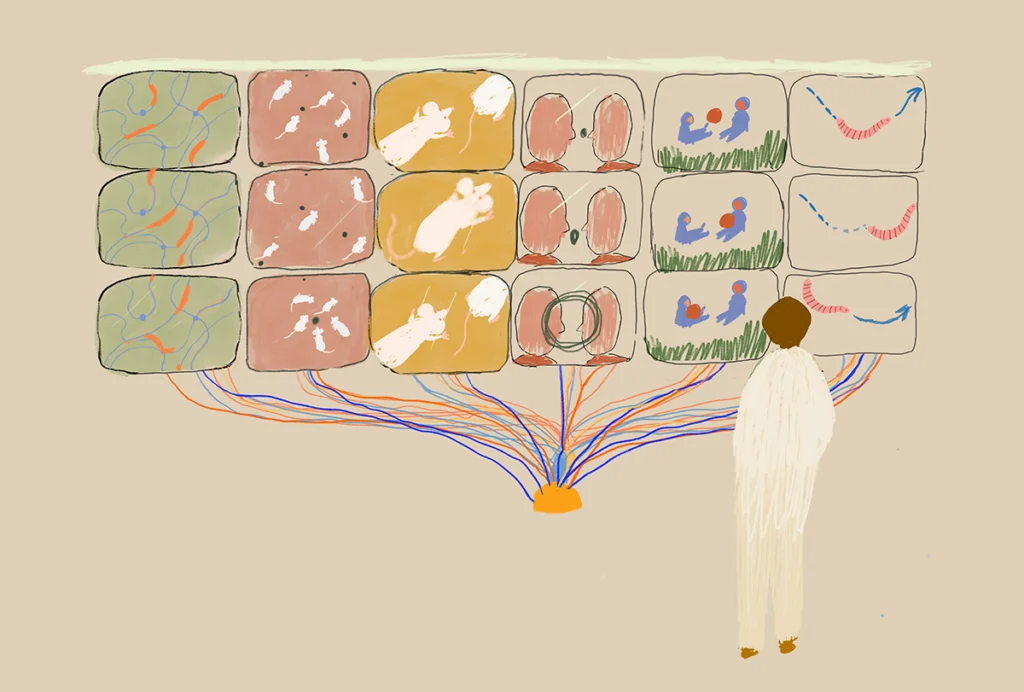Unleashing the power of DIY innovation in behavioral neuroscience
Widespread adoption of open-source tools calls for more support and training.
Recent innovations in neuroscience techniques have made possible experiments that could not have been imagined in the early days of the field. New methods for optical imaging and high-density electrode recording enable researchers to record more neurons at once in a single animal than they could record across an entire group of animals a decade ago. Complementary techniques have emerged for tracing neural circuits and perturbing specific neuronal populations. Researchers have openly shared these techniques, leading to an explosion of innovation, and not-for-profit vendors have quickly made the tools available. Thousands of research groups use them today.
By contrast, the laboratory equipment used for behavioral experiments has remained largely unchanged over this same period. The same behavioral control systems sold in the 1990s are sold today, with mostly incremental improvements. They use proprietary hardware and programming languages, making it difficult to modify these systems to interface with other kinds of data-acquisition systems and challenging to reproduce experimental designs across labs.
In response to these issues, researchers have developed their own tools, such as Bonsai and pyControl, which use modern hardware and programming interfaces. They have also developed powerful programs for video analysis, including DeepLabCut and SLEAP, which have capabilities beyond those of commercial vendors. Scientists have also created devices that offer functions not available commercially, such as the Feeding Experimentation Device (FED) for home-cage training mice in operant tasks.
These tools have numerous advantages: They are often more functional, cheaper and more readily modified based on user needs—researchers share computer code and hardware designs from these projects via websites, such as GitHub. Yet, except for methods for video analysis, these homegrown systems have not been as widely adopted as one might expect.
One reason for the slow adoption of open-source tools might be a lack of awareness in the neuroscience community. To address this issue, we launched the OpenBehavior project in 2016. At its center is a website to collect and share methods scattered across repositories, such as GitHub, Hackaday and other websites, as well as embedded in methods papers. The project grew a large following on social media, and we eventually secured funding from the National Science Foundation to support it.
As OpenBehavior took off, we recognized another challenge inhibiting the adoption of these tools. Many required some knowledge of coding and electronics. So we created workshops to teach those skills. The first set of workshops, held at the National Institutes of Health and at the Winter Conference on Brain Research in 2022 and 2023, focused on Arduino, a popular open-source electronics platform. Last November, preceding the annual Society for Neuroscience (SfN) meeting in Washington, D.C., we ran an expanded workshop, which added training on 3D printing, a series of talks by leading open-source developers, and time for extended discussions of the challenges that open-source tool developers and users face. It will take many more of these sorts of workshops to help behavioral neuroscience leverage the innovations made by a fraction of the field. But our conversations already have helped us identify ways to facilitate that process.
A
major topic of discussion at the SfN workshop concerned the same problem that led us to launch OpenBehavior—a lack of widespread adoption of open-source behavioral technology. Some attendees felt that lack of awareness was still an issue, too. Others noted a perception that labs turn to open-source tools only as low-cost options. (We contend they have many advantages, such as flexibility, rapid access and reproducibility.) Still others raised a more challenging concern—a wariness of using newly developed methods from non-commercial entities. Driving this concern was the lack of documentation and full-time technical support, as well as the pressure that labs are under to make progress on tight timelines. Setting up a new research tool can simply take too much time.Developing support for open-source tools is expensive; it requires funding for staff to write documentation, offer user support and maintain projects in the way that commercial entities do. Most federal funding sources in the United States and European Union encourage grant applications to create new research tools. But they do not support the development or maintenance of existing research tools, a major challenge for developers of open-source tools. Many successful projects have required extensive volunteer efforts to maintain them, which are not always sustainable.
Our discussion at the SfN workshop led us to three efforts that could help address these concerns, particularly the time and expertise required to bring new tools into research labs.
First, researchers could hire technical consultants to help train their research team on recently developed methods. Developers would be compensated for their time assisting other users, and new users could learn from the developers instead of working everything out on their own. Jakob Voigts recently proposed this idea in an article for The Transmitter. As Voigts noted, this approach will require a shift from funders. Currently, support for external professional experts is sometimes raised as a weakness in grant proposals, so funders would need to ensure that including technical consultants in grant proposals would not negatively influence funding outcomes.
Second, more regular discussions among researchers on technical topics could speed up the process of bringing new tools into research labs. Social media has been great for some people to get quick support on a project. But not everyone sees such helpful posts. Online forums seem to be a better option, and a few such forums exist to this end. The NeuroMethods Slack group, organized by Ben Saunders, for example, offers technical support on a variety of methods used in neuroscience research. TheBehaviourForum.org is an online forum for discussing animal behavioral research. Finally, in response to feedback at our pre-SfN workshop, the OpenBehavior project launched a new Discord server, which aims is to offer a space for neuroscientists to interact as they learn how to make and use open-source research tools.
Third, online courses could address the technical skills gap. For example, courses in computer programming, electronics and 3D printing could be tailored to the specific needs of neuroscientists. The CAJAL Advanced Neuroscience Training Programme and Neuromatch Academy offer training on current methods, including optogenetics and computational neuroscience. New offerings from these programs could be a great way to deliver content to a wide audience and perhaps accelerate the adoption of new methods into research labs.
Recommended reading

Designing an open-source microscope

Neuroscience needs a research-video archive
Explore more from The Transmitter

Building an autism research registry: Q&A with Tony Charman


